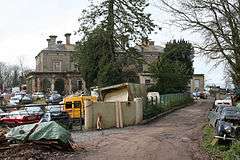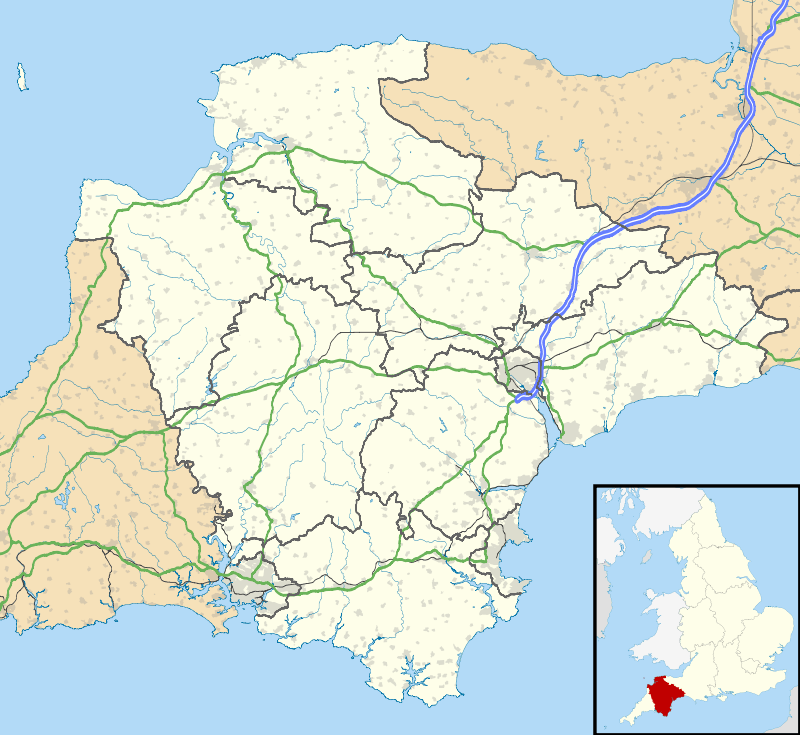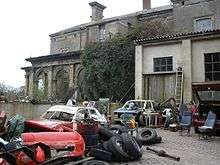Blackborough House
Blackborough House is a grade II listed country house in Blackborough, Devon, 3 miles (5 km) east of Cullompton. It was built in 1838 and is currently in a semi-derelict state.
 Blackborough House in 2006 | |
 location within Devon | |
| General information | |
|---|---|
| Status | renovation planned |
| Type | Country house |
| Architectural style | Italianate |
| Town or city | Blackborough, Devon |
| Country | England |
| Coordinates | 50°52′46.1″N 3°17′42.4″W |
| Groundbreaking | 1838 |
| Completed | 1840 |
| Grounds | 10 acres (4 ha) |
| Design and construction | |
| Architect | James Thomas Knowles |
| Other information | |
| Number of rooms | 60 |
Construction
It was built in 1838 by James T. Knowles for George Wyndham, 4th Earl of Egremont, of Orchard Wyndham, Somerset. Originally designed as an Italianate palace, there were no funds to complete it on such a scale, so it was constructed as two smaller, linked buildings for the Earl and his cousin, the local rector. His other nearby palatial Devon residence Silverton Park, (demolished in 1901) was also designed in this style but was never completed.
The house is a square block constructed from stuccoed brick, with stone dressings and has hipped slate roofs with red ridge tiles. It has an arched colonnade or loggia around it on three sides and has two separate sets of stairs on either side so that each half of the house could be accessed independently. These entrance towers were originally 70 feet (21 m) tall but the top stage of each has been dismantled. There are two service wings around a courtyard and the building is two storeys tall throughout with a total of 60 rooms. There are small square windows on the upper floors designed to resemble the gunports of George Wyndham's ship, HMS Hawke. The central court yard, was covered in a glass dome and acted as a great hall but no longer has any sort of roof. The house has 10 acres (4 ha) of grounds surrounding it.[1][2][3][4]
History of owners and uses

The Devonshire historian Pole (d.1635)[5] gives the arms of "Bolegh of Blackburgh Bolley" as: Argent, on a chevron sable three bezants between three torteaux. This is the family of "Bolley (or Bolhay)" mentioned by Chalk (1910).[6] The house was used as the rectory until 1894 and for some of that time was also a school for local children.[3] In the middle of the nineteenth century a group of mostly Irish students studied with the Rev. William Cookesley Thompson at the house. Around the start of the twentieth century it was rented by an old woman and her daughter.[7] From 1930 to 1939 it was a home for vagrants run by the council and the Church of England.[8][9] It was a Quaker training centre for conscientious objectors doing relief work during World War II.[10] From 1943 to 1946 or 1947, while still owned by the Quakers, it was used a YHA Youth Hostel known as Spiceland (named after the location of a Friends Meeting House, several miles away in the parish of Uffculme).[11] It became a vehicle breakers' yard in 1951. In 2013 the house was used as a location in a low budget horror movie called In Fear.[12]
Decline and restoration plans
| Wikimedia Commons has media related to Blackborough House. |
By 2011 the house was semi-derelict and had long been surrounded by a car scrap yard[2] owned since about 1995 by Ralph Sanders, an amateur racing driver,[13] who operated a car spare-parts business and was said to have old racing cars parked inside the house.[14] The house featured in Trials and Tribulations an episode of the second series of the TV series Shed and buried, broadcast on 24 January 2017 on the Travel Channel,[15] where Henry and Sam purchased an old Triumph trials bike (stored within the house) from owner Ralph Sanders.
In 2011 the house and 12 acres (5 ha) were for sale for £1m (later reduced to £750,000), but did not sell, and was subsequently withdrawn.[16]
In 2015 a sale was agreed for the house and 10 acres (4 ha) to a developer, to be completed by the end of 2016. On 17 September 2016 an auction was held, in preparation for the house sale, of 1,000-plus lots of motor vehicle remains and spare parts that occupied the house and grounds.[8]
In 2018 planning permission was requested to develop the house and grounds into a 64 bedroom hotel and spa with four linked pavilions and seven detached villas in the grounds.[17] The developers also plan to restore the seventy-foot towers which originally stood on the east and west sides and put a glass roof on the inner courtyard as well as adding a new low level extension. It will then be used as an events venue holding weddings, corporate events and exhibitions.[18] Local residents have opposed the proposals on a number of grounds, in particular the extra traffic which would be generated both during the development and when in use as a hotel. Mr Southerden, a spokesman for a group opposing the proposal expressed concern that it was being put forward as an 'Enabling Development' which the group saw as essentially being a loophole in planning law.[17]
References
- Cherry, Bridget; Nikolaus Pevsner (2004). The buildings of England: Devon. New Haven and London: Yale University Press. p. 187. ISBN 0-300-09596-1.
- "Buildings at risk for sale - take your pick!". Save Britain's Heritage. Retrieved 17 September 2016.
- "The History". Blackborough House. Retrieved 17 September 2016.
- Historic England. "BLACKBOROUGH HOUSE (1106499)". National Heritage List for England. Retrieved 18 September 2016.
- Pole, Sir William (d.1635), Collections Towards a Description of the County of Devon, Sir John-William de la Pole (ed.), London, 1791, p.470
- Rev. Edwin S. Chalk, MA, The Manors, Parish and Church of Blackborough alias All Hallows, published in: Transactions of the Devonshire Association, Vol.42, (1910) pp. 346-360
- Snell, Frederick John (1906). The Blackmore country. London: A. and C. Black. pp. 47–48. Retrieved 29 October 2016.
- "Historic contents of crumbling mansion including Jaguar graveyard being sold at auction". Exeter Express and Echo. 13 September 2016. Archived from the original on 14 September 2016. Retrieved 17 September 2016.
- Rugg, Derrick V. (1983). Across Cobble Stones. Padstow: Tabb House. pp. 52–53. ISBN 090701819X.
- Smith, Stanley (1990). Spiceland Quaker Training Centre, Cups without saucers. York: William Sessions Limited. ISBN 1 85072 064 9.
- Martin, John (1 January 2014). "Quaker, Socialist and other philanthropic influences in YHA's early history" (PDF). Cadbury Research Library: Special Collections, University of Birmingham. Retrieved 18 September 2016.
- "Grade-II listed Devon mansion and mill included in dereliction hall of shame". This is Devon. Archived from the original on 5 May 2013.
- "Banger racing bonanza". Somerset County Gazette. 11 July 2007. Retrieved 17 September 2016.
- "Mouldy Old Dough Banger Racing". Facebook. Retrieved 17 September 2016.
- Episode previewed as: "Henry and Sam head down to a large old house in the depths of Devon's countryside. There are piles of cars wherever they look, and bikes seem to appear out of every nook and cranny. They are spoilt for choice, but what will they bid on?"
- "11 bedroom detached house for sale". Rightmove. 3 May 2011. Retrieved 17 September 2016.
- Clarke, Lewis (5 February 2018). "Villagers say no to plans to turn historic Blackborough House into luxury hotel and spa". Devon Live. Retrieved 9 March 2018.
- "The Future of Blackborough House". Blackborough House. Retrieved 17 September 2016.